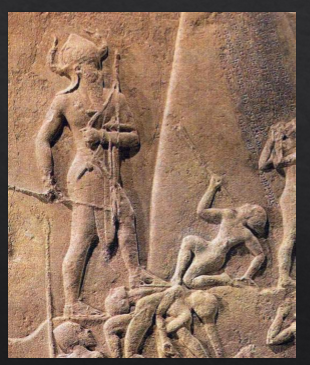mesopotamia
1/18
There's no tags or description
Looks like no tags are added yet.
Name | Mastery | Learn | Test | Matching | Spaced |
|---|
No study sessions yet.
19 Terms
Mesopotamia before the creation of city states
Samarra phase
6500 to 5900 BCE
Halafian phase
6100 to 5100 BCE
Hassuna phase
Around 6500 BCE
ubaid phase
6000 to 4200 BCE
ubaid phase
The foundation for the mesopotamian civilization
One of the first ever widespread cultures
Farmers settle in the southern plain and establish villages
Began temple institution (the central point of the society) and expansion of irrigation
eridu
In 4500 BCE
Urbanization
2 tiered
Irrigation
Plow farming
The settlement was unwalled
The ubaid culture spread across:
Eridu, northern plain, Persian Gulf coast, Oman (copper)
Because traders would move to places with materials
They sailed
Evidence is Ubaid pottery found in Egypt
temple institution
The focus of the ubaid society
Held patron gods and religious authority
Responsible for:
irrigation
water allocation
Powerful because they lived on a floodplain
trade
because they had storage facilities
Main land holders and employers of the land
Settlements tend to grow around temples
At this point not yet priest rulers
Influence still limited but grew as settlements grew
Not coercive
Produced and received the surplus of the land
Allowed them to obtain luxury items which reinforce their status
The priests started wearing the regalia that belonged to the temple which began the process of them being in a higher class
uruk revolution
4200 to 3100 BCE
The beginning of the first city and city states
Cities were walled
There were smaller centres and agricultural centres
Had writing, wheeled vehicles, craft specialization
Religion was centralized but control was secular
The first king
Trading networks expanded
Social hierarchy is evident
Beyond just priests and farmers
uruk
the city
aka warka
Had full time bureaucracy, military
social hierarchy
4 tiered based on settlement
The first ever true city
Largest of the uruk period
Huge increase in number of settlements after 4000 BCE
40,000 to 80,000 people
tells
Artificial mounds
made of Mud brick buildings that collapsed and rubbish of city dwellers
The main remnant of Mesopotamian cities
In various abandoned places in the desert because rivers changed their course
secular rulers
There was a government That included a secular ruler in the uruk period
Evidence
Images of men taking enemies and prisoners
Sculptures of male individuals with long hair, beard, and net skirts that possibly was the ruler
Men dominated politics even though both genders were prominent in temple institutions
cult deities
Imagery of gods were made from wood and covered in gold
According to sumerian written records
Gods were in the idol itself and in the spiritual realm
They were carried through communities
Feasts were organized for them and they were praised
They had great influence over peoples lives
sumerian civilization
Within the early dynastic period
2900 to 2350 BCE
early dynastic period
Written records were for more than just trade
Including kings lists, literature, poetry
The age of the southern sumerian city states
The southern plain was divided into two parts
Sumer = South
Akkad = north
the bronze age
Bronze is an alloy of copper and tin
More stronger and durable
Better for agriculture
warfare
Used for weapons and wheeled vehicles that were pulled by donkeys or ox
trade
Afghanistan
Lapus lazuli
Anatolia AKA Turkey
Obsidian
chert
Lead
Gold
Silver
Persian Gulf
Copper
pearls
Southern Arabia
Steatite
Diorite
Copper
Indus
Carnelian
cemetery of the city of Ur
Just outside of the city
Excavated by Woolley in 1922
2500+ burials
Simply pits with people wrapped in mats or in a wooden coffin
16 graves were royal
Had lavish goods
Buried in brick or stone chambers
Included human sacrifices and prestigious objects
Human sacrifices stopped being a thing after the early dynastic period
queen puabi
She was placed on a wooden bier (bed)
Cloaked with lapis
Gold and carnelian beads, wigs, gold bands
Included three attendants
A death pit surrounded her consisting of men, female attendance, oxen, grooms
A total of 59 human sacrifices
Most of them were also wearing gold and silver jewelry
Under her tomb is that of a man who might be her husband
He had 19 female and two male sacrifices
6 oxen
Chariots, musical instruments, silver objects
akkadian empire
2334 to 2230 BCE
About 50 years
The first empire of the near east
Lebanon, syria, anatolia, southern Mesopotamia
Biggest expansion was under the grandson of sargon the first, naram-sin
Rulers after this increased irrigation to increase wealth but it wasn't enough to sustain the empire
Collapse due to drought, outside pressure, bad ruling
sargon I
A priestess had a son in secret
Sargon means legitimate ruler
Probably making up for the fact that he was a usurper
the myth
He was placed in the basket on the Euphrates
Was found and raised at the Royal Court and became a ruler
Just like Moses's story
Kingship used to shift amongst the city states but now there was 1 ruler
A great warrior
He established iconography for the male form and depicted rulers to be larger than life
naram sin of akkad
Declares himself divine
Both the spiritual and secular authority
Undermines the authority of the temple
The temple is still very powerful
Not sure if his authority exerted over the larger city states
They were defeated by him but they weren't necessarily controlled
the image
depicts himself with a helmet with horns which only gods wear
Larger than the other figures to show himself as God

imperial Ur
2112 to 2004 BCE
The third dynasty of Ur
An important port for Indian Ocean trade
Influence expanded through diplomacy and religion not warfare
More emphasis on alliances
Had large ziggurats, wrote codes of law found in tablets in nippur